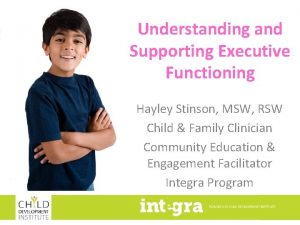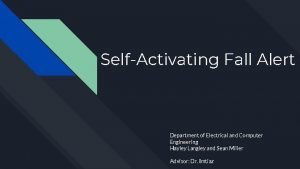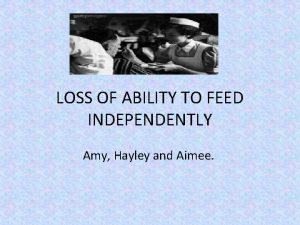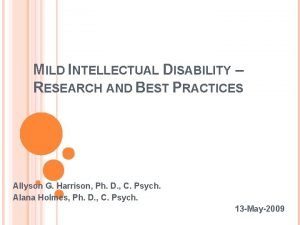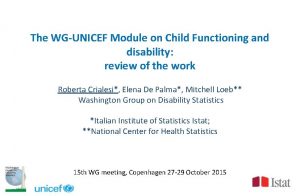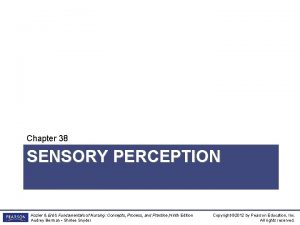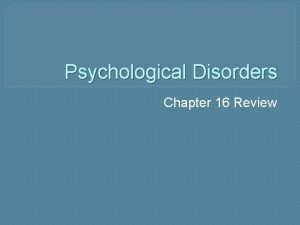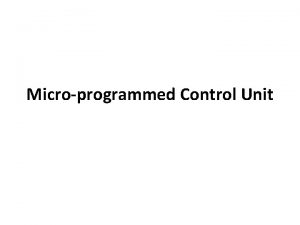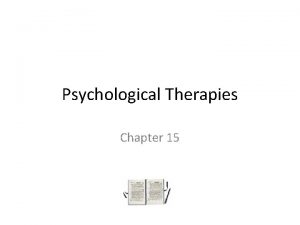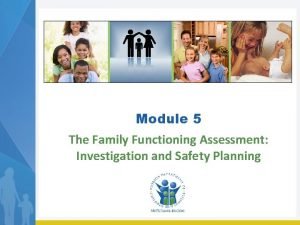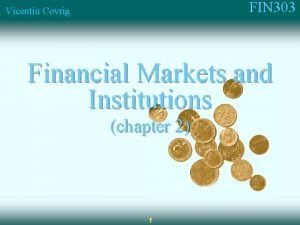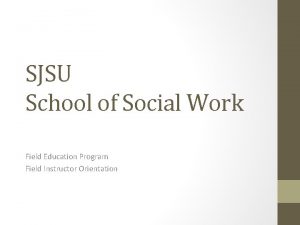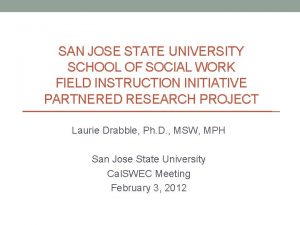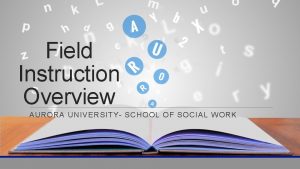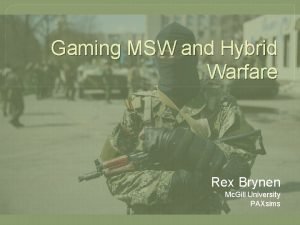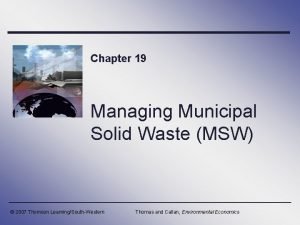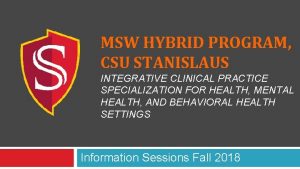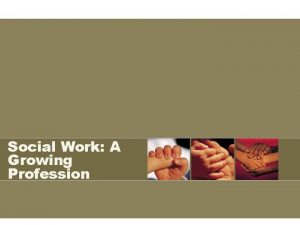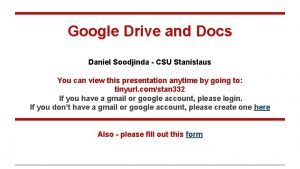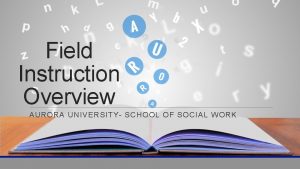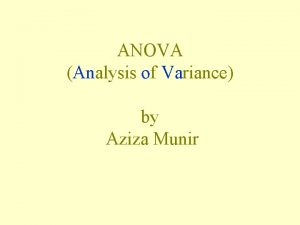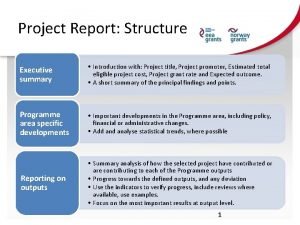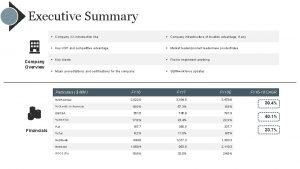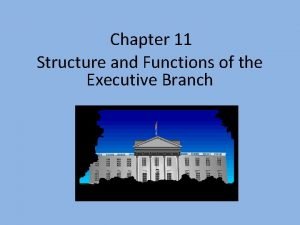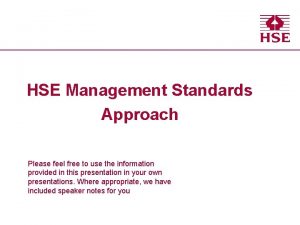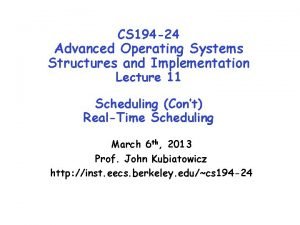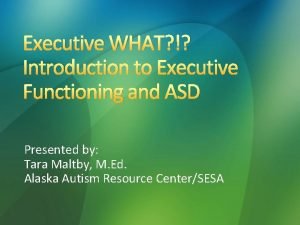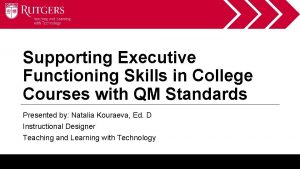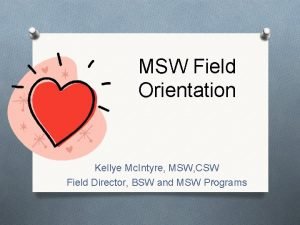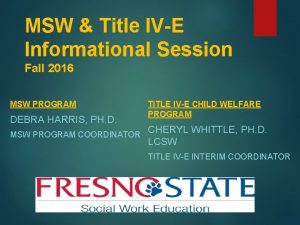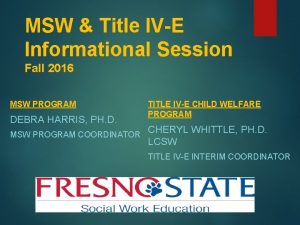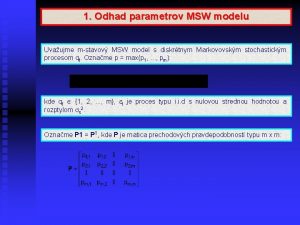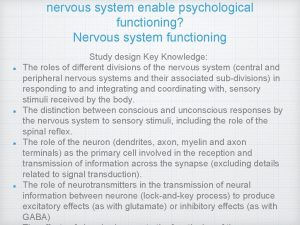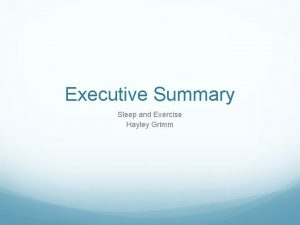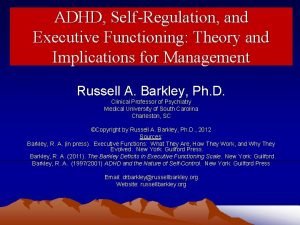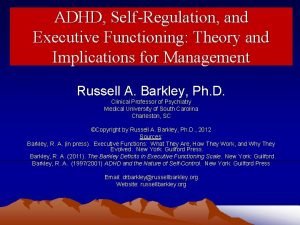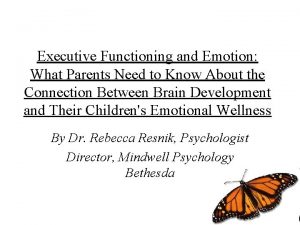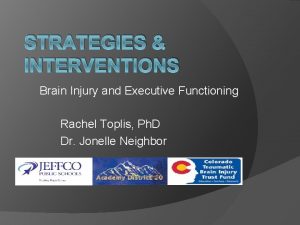Understanding and Supporting Executive Functioning Hayley Stinson MSW








































































- Slides: 72

Understanding and Supporting Executive Functioning Hayley Stinson, MSW, RSW Child & Family Clinician Community Education & Engagement Facilitator Integra Program

Child Development Institute Early Intervention Services Family Violence Services Integra Program Healthy Child Development

Learning Objectives • To better understand executive functioning in children with LDs / ADHD • To explore the challenges associated with executive functioning deficits • To discuss practical strategies to support children with executive functioning deficits

Our Framework • Our understanding of the problem determines our solution • “Kids do well if they can” (Ross Greene) - if they can’t something is getting in the way and they need support in figuring out what it is and what will help • Not a lack of WILL, it’s a lack of SKILL

Learning Disabilities (LDs)

What are LDs? Neurodevelopmental disorders Affect one or more ways that a person • Takes in • Understands • Remembers • Expresses information Average to above average thinking and reasoning skills - Kids with LDs are smart! Lifelong and may present differently at different stages 5 to 10 % of Canadians have LDs (LDAO, 2001)

What are LDs? Impairments in one or more of the following psychological processes: • Language Processing • Phonological Processing • Visual-Spatial Processing • Processing Speed • Memory and Attention • Executive Functioning • Visual Motor Processing

Academics Reading, writing, math, oral language Social Interactions Reading social cues Learning Disabilities Behaviour Following instructions Emotion Regulation Explosions, freezing up

Explaining Behaviour Non-compliant Outbursts Externalizing Withdrawal Avoidance Internalizing • Anxiety? Depression? • LD? ADHD? Learning Challenges? • Physical Issue – Sleep? Hunger? Sensory integration? • Environmental Issue – Change at home? Learned Behaviour? • Social Issue – Conflict with peers?

Behaviours as Communication • Behaviours/’symptoms’ communicate our way of coping with painful, intense, negative emotions (e. g. , emotion regulation strategy) • I feel ____ and I cope with it by “behaviour/symptom” to feel better • E. g. , I feel fear/shame and I cope with it by avoiding, worrying, controlling to feel better

Challenging Behaviours Arise When… Skills and Ability to Cope Demands of Environment “Kids do well if they can” (Ross Green)

LDs and Stress Experience of Repeated Failure Anxiety about meeting expectations Lower Sense of Mastery Frustration Patterns of Experiential Avoidance

Experiential Avoidance • Avoid interactions, activities, thoughts, and emotions associated with failure or distress by: – withdrawing from the stressful situation – engaging in problem behaviors that facilitate avoidance or distract (Ducharme & Harris, 2005) – pushing away unwanted thoughts – drugs and alcohol Miss out on opportunities that build resilience and mastery

Executive Functioning

What is Executive Functioning? • Umbrella term – includes various skills and function of the prefrontal cortex (neurologically based) • Responsible for mental control and self-regulation • Developmental – develops with maturity from infancy through early adulthood (age 25), not just a matter of teaching skills

Another Way to Think About EF EXECUTIVE FUNCTIONING OTHER PROCESSES

Executive Functioning Skills • Response inhibition: the capacity to think before you act (ability to resist the urge to say / do something) • Working memory: the ability to hold information in memory while performing complex tasks • Emotional control: the ability to manage emotions to achieve goals, complete tasks, or control and direct behaviour (Guare, Dawson & Guare, Smart but Scattered, 2012)

Executive Functioning Skills • Flexibility: the ability to revise plans in the face of obstacles, setbacks, new information or mistakes • Sustained attention: the capacity to maintain attention to a situation or task in spite of distractibility, fatigue or boredom • Task initiation: the ability to begin projects without undue procrastination (efficiently and timely) (Guare, Dawson & Guare, Smart but Scattered, 2012)

Executive Functioning Skills • Planning / prioritizing: the ability to create a road map to reach a goal or to complete a task • Organization: the ability to create and maintain systems to keep track of information and materials • Time management: the capacity to estimate how much time one has, how to allocate it, and how to stay within time limits and deadlines (Guare, Dawson & Guare, Smart but Scattered, 2012)

Executive Functioning Skills • Goal-directed behaviour: the capacity to have a goal, follow through to the completion of the goal and to not be put off or distracted by competing interests • Metacognition: the ability to stand back and take a birds eye view of yourself in a situation, to observe how you problem solve (Guare, Dawson & Guare, Smart but Scattered, 2012)

Everyday Tasks Requiring EF Task Executive Functions Chores (e. g. , vacuuming the floor, cleaning room, washing the dishes) Task initiation, planning / prioritizing, organization, time management, goaldirected persistence, sustained attention Learning to control his or her temper Emotional control, response inhibition, flexibility Getting ready in the morning Planning / prioritizing, organization, task initiation, time management, goaldirected persistence School challenges (e. g. , homework, chronic lateness, problems completing assignments, difficulty preparing for tests and exams) Depending on the nature of the issue, any one of the 11 executive functioning skills, alone or in combination, may be involved (Guare, Dawson & Guare, Smart but Scattered children, 2012)

Executive Functioning and ADHD • Kids with Attention Deficit Hyperactive Disorder (ADHD) have problems with executive functioning • But not all kids with executive functioning problems have ADHD • Three types of ADHD: – Hyperactive – Inattentive – Combined Executive Functioning Problems ADHD Inattentive Hyperactive Combined

EF and Learning Disabilities • EF and LDs go hand-in hand • EF – one of the psychological process which may be impaired in kids with LDs • EF problems often go with other kinds of processing problems • Each kids profile is unique LDs EF ADHD

EF and 22 q 11 DS • Many children with 22 q 11 Ds also struggle with executive functioning and attention

Stroop Task / Stoop Effect

Read Each Word Aloud Red Green Yellow Blue Green Pink Blue Pink Red Green Pink Red 0: 15 0: 14 0: 13 0: 12 0: 11 0: 10 0: 09 0: 08 0: 07 0: 06 0: 05 0: 04 0: 03 0: 02 0: 01 0: 00

Read Each Word Aloud Yellow Blue Pink Red Green Pink Blue Green Red Green Yellow Red Pink Blue 0: 20 0: 19 0: 18 0: 17 0: 16 0: 15 0: 14 0: 13 0: 12 0: 11 0: 10 0: 09 0: 08 0: 07 0: 06 0: 05 0: 04 0: 03 0: 02 0: 01 0: 00

Name the Colour Aloud Blue Green Yellow Pink Blue Pink Green Red Pink Red Yellow Blue Green 0: 30 0: 29 0: 28 0: 27 0: 26 0: 25 0: 24 0: 23 0: 22 0: 21 0: 20 0: 19 0: 18 0: 17 0: 16 0: 15 0: 14 0: 13 0: 12 0: 11 0: 10 0: 09 0: 08 0: 07 0: 06 0: 05 0: 04 0: 03 0: 02 0: 01 0: 00

Executive Functioning Skills • What EF skills did you use during the Stroop Task? – – – Response inhibition Working memory Emotional control Flexibility Sustained attention Task initiation – – – Planning / prioritization Organization Time management Goal-directed persistence Meta cognition

WHAT BEHAVIOURS DO YOU SEE IN CHILDREN WITH LD’S / ADHD RELATED TO EXECUTIVE FUNCTIONING CHALLENGES?

Emotion Regulation

Emotion Regulation Emotion regulation is our ability to control or manage our emotional responses to arousing situations.

Emotion Dysregulation • Person whose responses are chronically out of control (in the red zone – severe, persistent, interferes with everyday life) • Experience symptoms more intensely and frequently – “Super feelers” (Emotion-Focused Family Therapy)

Bucket of Emotions

Under-Regulation Vs. Over-Regulation

Under-Regulated Emotions • Not able to control emotions enough • Stuck in “on” button, trouble putting brakes on • Externalization of emotions (directed outward) • Patterns of “fight” (behavioural challenges) • Need help from adults to regain control of emotions

What You May See UNDER- REGULATION • Meltdowns – crying, yelling, kicking, screaming, throwing self on the ground • Go from 0 -100 quickly • Impulsivity and hyperactivity • Aggressive behaviour – hitting, throwing things, yelling, name calling, fighting • Trouble following directions • Quick tempered, over reacts, easily frustrated • Mood swings • Trouble calming down or recovering from disappointment, holds grudges • Blames others or quick to call things “unfair” when doesn’t meet goals

Over-Regulated Emotions • Try's to control emotions too much • Stuck in “off” button, trouble revving up • Internalization of emotions (directed inwards) • Patterns of “flight” (or “freeze) – avoidance • Need help from adults to express themselves and their emotions

What You May See OVER-REGULATION • Withdrawing • Avoidance • School refusal • Shutting down • Dreaminess, zoning out • Turning away from others • On the sidelines • Easily overwhelmed – worries become paralyzing, worry too much about small things • Becomes easily upset

Meet Aaron • • Aaron is 7 years old Bright, creative, imaginative He is very distracted He is disruptive and will act silly with his peers He has trouble fitting in socially He gets easily frustrated when things don’t go as planned He has trouble with transitions He is very angry when he feels mistreated or thinks something is unfair

Taking a Closer Look What EF skills might be lagging behind for Aaron? Plan of Action: 1. Set age appropriate expectations 2. Modify the environment 3. Teach lagging skills

Strategies to Support Children with EF Challenges

Identifying Strengths • Identify and understand both the factors contributing to the child’s successes and the factors standing in the way of their successes – Celebrate the child’s strengths – Support the child in improving their skills and developing compensative strategies (i. e. , using their strengths to compensate for areas of weakness) (Guare, Dawson & Guare, Smart but Scattered, 2012)

Appropriate Expectations • Children with LDs/ADHD may require more support and supervision than other children their age • EF skill development is gradual – it will take time, practice, and opportunities for mastery • Children benefit from frequent check-ins: – Before beginning tasks – During tasks – Before shifting tasks (transitioning)

Scaffolding

Dependence to Independence • Job is not to “do for” • Job is to “help them do” – Sustaining attention, transitioning from task to task, managing and regulating emotions – Organizing, supporting, communicating, allocating time, scheduling • Operating as an external frontal lobe (Greene, Collaborative Problem Solving)

Don’t Cue to Do, Cue to Know What to Do “How are you going to know when to be ready? ” “How are you going to stop yourself from…? ” “What is your goal? ” “What do you want it to look like? ” “How long do you think it will take? ” “How much did time did it take last time? ” “How are you going decide where to set that up? ” “How are you going to know what you need? ” “How are you going to know what is most important? ” “How are you going to decide what to do first? ” “How will you know when you are done? ” “How will you continue when you are tired? ” “How did that work out? ” “How long do you think that took? ” “How did you manage/know how to do it? ” “Would you do anything differently? ” “Have you done anything like this before? ” “Was that harder or easier than…. ” (Sarah Ward, M. S. , CCC/SLP)

Modifying the Environment 1. Changing the physical or social environment – Alarm clocks, organizing systems for study materials / room keeping, wall or desk calendars, whiteboards for schedules, colour coding – Reduce distractions 2. Changing the nature of the task – Break tasks into pieces, shorten tasks, reduce the amount of work, provide clear steps (Guare, Dawson & Guare, Smart but Scattered, 2012)

Teaching EF Skills • Directly teach EF skills – E. g. , collaboratively identify an EF skills, set a goal, outline / break down the steps needed to reach the goal, supervise, fade supervision • Use everyday activities to teach EF skills – E. g. , games (checkers, chess), cleaning up, etc. – Find natural teachable moments – Cue the skill the child needs to use in the moment

Validation

Validation 1. Attend • (Notice, pay attention, tune “in” vs “out”) 2. Label the emotion • (Name it, speak the unspoken) 3. Validate • (3 -5 x because – “it make sense you are feeling ____ because…”) 4. Meet the emotional need/support • Emotional need (comfort, reassurance, space) • Practical need (set limits, redirect, problem solve, take over) (Emotion Focused Family Therapy)

Tips for Emotional Control • Model self-regulation – Use positive self talk (e. g. , “I need a break”) • Prepare your child – talk to him/her about what to expect and what to do if his/her emotions build up • Decrease opportunities for emotions to build up – – Clear expectations, predictability, warnings for transitions Encourage breaks and time for movement View mistakes as a natural part of the learning process Prepare for trouble spots, practice what to do, role play

Tips for Emotional Control • Offer to help problem solve a better way to manage the emotion once everyone is calm • Teach and practice relaxation skills – Calm breathing, muscle relaxation, movement breaks – Practice relaxation skills throughout the day

Tips for Flexibility • Manage the environment – Schedules and routines – Advanced notice for what is happening next “you have five minutes before you have to start your homework” – Rehearse the situation in advance and walk your child through what might happen – Reduce the complexity of the task (break the task down into smaller pieces)

Tips for Flexibility • Walk your child through stressful or anxiety provoking situations • Support your child in coming up with a strategy for handling situations where his or her inflexibility might cause problems – Count to 10 – Walk away – Ask for help

Tips for Working Memory • Break information / instructions / tasks into individual steps (chunk) and provide steps one at a time • Have the child work on one step at a time, and check in before moving to the next step • Provide information in multiple ways (speak it, show it, create opportunities to practice it) • Use external aids (visuals, sticky notes, checklists) • Establish routines

Tips for Working Memory • Keep rules and directions short, clear, and specific • Give instructions one at a time and repeat if necessary • Demonstrate what is to be done (model what you need to do at each step or how to perform the task) • Make information meaningful (e. g. make into a story, relate to areas of interest, past experiences or knowledge) • Repetition, repetition

Tips for Planning and Organization • Help identify goals and create a step-by-step plan • Write the steps down, assist with monitoring progress, provide frequent feedback • Prompt and cue your child – “What do you need to do first? And then what? ” what is the most important thing you need to do today”) • When developing a plan or organizational system involve your child as much as possible

Tips for Planning and Organization • Develop and maintain organization systems and structures (e. g. , bins, baskets, checklists) • Create a visual for the space once it is organized (for comparison) – Photo or drawing of his/her clean room – Example of an organized binder – Prompt or cue to view the visual when your child appears stuck

Tips for Planning and Organization Example of a Checklist for Getting Ready in the Morning • The Night Before – Put all homework in backpack – Put other things in backpack (gym clothes) – Get clothes ready for tomorrow – Set alarm – Lights of by 10 pm • In the Morning – Get out of bed (and only snooze alarm once) – Take 10 minutes shower – Get dressed – Eat breakfast – Brush teeth – Ready for school by 7 am

Tips for Time Management • Create predictable daily routines in your family (e. g. , wakeup time, bedtime, meals) • Talk to your child about how long it typically takes to complete certain activities or tasks (e. g. , chores, completing homework) • Use timers and clocks to show your child how much time your child has left for the activity or task • Use calendars and schedules

Authentic Praise • Offer praise when your child is able to use their EF skills – Authentic and genuine praise will bring attention to how they handled a task or situation • Recognize, praise and reinforce efforts not just results

Questions? Thank You!

For More Information Hayley Stinson, MSW, RSW Child & Family Clinician Community Education & Engagement Facilitator Integra Program, Child Development Institute 25 Imperial St, Toronto ON hstinson@childdevelop. ca 416 603 1827 ext 5233

Resources on Collaborative Problem Solving (Ross Greene) • Lives in the Balance www. livesinthebalance. org • Lost at school: Why our kids with behavioural challenges are falling through the cracks and how we can help them (Ross Greene)

Resources on Learning Disabilities • Integra Handbook on LDMH www. childdevelop. ca/programs/integra-program • Learning Disability Association of Ontario (LDAO) www. ldao. ca • LD@Home www. ldathome. ca

Resources on Learning Disabilities • National Centre for Learning Disabilities (NCLD) www. ncld. org • Smart Kids with Learning Disabilities www. smartkidswithld. org • LDAO and Integra Program Learning Module on LDMH www. ldatschool. ca/learning-modules/mental-healthintegra/overview/

Resources on ADHD • Teach ADHD (The Hospital for Sick Children) www. research. aboutkidshealth. ca/teachadhd/ • ADHD Resource Centre (The Hospital for Sick Children) www. aboutkidshealth. ca/en/resourcecentres/adhd • Children and Adults with ADHD (CHADD) www. chadd. org/ • ADHD and the Nature of Self Control (Dr. Russel Barkley)

Resources on Executive Functioning • Executive Functioning 101 www. understood. org • Smart but scattered series (Ped Dawson and Richard Guare) • No mind left behind (Adam Cox) • Executive functions: What they are, how they work, and why they evolved (Dr. Russel Barkley) • New Understandings of ADHD and Executive Functions (Dr. Tom Brown)

Resources on Mental Health • The ABC’s of Mental Health www. hincksdellcrest. org/ABC • The Hospital for Sick Children www. aboutkidshealth. ca • Children’s Mental Health Ontario (CMHO) www. kidsmentalhealth. ca • Kids Help Phone www. kidshelpphone. ca • Anxiety. BC www. anxietybc. com • EFFT www. mentalhealthfoundations. ca

Resources for Educators • LD@School www. ldatschool. ca • Ontario Teacher’s Federation: Teacher’s Gateway to Special Education http: //www. teachspeced. ca • Alberta Education: Diverse Learning Needs http: //education. alberta. ca/admin/supportingstuden t/diverselearning. aspx • Alberta Can learn Society: Take Ten Series http: //canlearnsociety. ca/resources/take-ten-series/

Resources Resource for Educators • The ABC’s of Mental Health: Teacher Resource www. hincksdellcrest. org/ABC/Teacher. Resource/Welcome • Make a Difference: An Educators Guide to Child and Youth mental Health Problems www. cymhin. ca • Executive skills in children and adolescents: A practical guide to assessment and intervention (Ped Dawson and Richard Guare)
 Hailey stinson
Hailey stinson How i met your mother hypnoweb
How i met your mother hypnoweb Paula stinson
Paula stinson Nathan stinson
Nathan stinson Vp managed care
Vp managed care Hayley dalton
Hayley dalton Hayley group poole
Hayley group poole Hayley langley
Hayley langley Hayley berlent
Hayley berlent Hayley turnham
Hayley turnham Simon hayley
Simon hayley Hayley pedersen
Hayley pedersen Rubik's cube and group theory
Rubik's cube and group theory Ablenow
Ablenow What is child functioning module
What is child functioning module Accommodations for borderline intellectual functioning
Accommodations for borderline intellectual functioning Adaptive functioning
Adaptive functioning Borderline intellectual functioning
Borderline intellectual functioning Adaptive functioning
Adaptive functioning High functioning autism symptoms
High functioning autism symptoms Child functioning module
Child functioning module Sensory functioning fundamentals of nursing
Sensory functioning fundamentals of nursing Process of striving toward ideal functioning
Process of striving toward ideal functioning Functioning of micro programmed control unit
Functioning of micro programmed control unit Phrasal verb of stop working
Phrasal verb of stop working Bod incubator principle
Bod incubator principle Therapies that directly affect the biological functioning
Therapies that directly affect the biological functioning Six domains of the family functioning assessment
Six domains of the family functioning assessment Stimming
Stimming Five principles of psychological functioning
Five principles of psychological functioning Well functioning financial markets
Well functioning financial markets Msw rhossili
Msw rhossili Msw sjsu
Msw sjsu Msw vtmis
Msw vtmis Hazardous waste apes
Hazardous waste apes Sjsu school of social work
Sjsu school of social work Salem state msw
Salem state msw Logo programming
Logo programming Aurora university msw
Aurora university msw Fau msw
Fau msw Social work competencies
Social work competencies Ut arlington msw
Ut arlington msw Msw scholarships 2019
Msw scholarships 2019 Msw 21 sevilla
Msw 21 sevilla Msw games
Msw games Ucsf warn me
Ucsf warn me A flat fee pricing system for msw services
A flat fee pricing system for msw services Edall button in msw logo
Edall button in msw logo Windlass healthcare
Windlass healthcare Western michigan university social work
Western michigan university social work Csu stanislaus msw
Csu stanislaus msw Conjunción oposición cuadratura trigono sextil
Conjunción oposición cuadratura trigono sextil Csumb
Csumb University of memphis msw
University of memphis msw Msw
Msw Salem state school of social work
Salem state school of social work Fd msw
Fd msw Fms logo
Fms logo Aka.msw
Aka.msw Daniel soodjinda
Daniel soodjinda Aurora university msw
Aurora university msw F=msb/msw
F=msb/msw Structure of summary
Structure of summary Legislative, executive, and judicial,
Legislative, executive, and judicial, Gartner 2017 cio agenda pdf
Gartner 2017 cio agenda pdf Executive summary and introduction
Executive summary and introduction Function of executive structure
Function of executive structure Education audiovisual and culture executive agency eacea
Education audiovisual and culture executive agency eacea Executive officer dwp salary
Executive officer dwp salary Lynn krage
Lynn krage Hse management standards analysis tool
Hse management standards analysis tool Cyclic executive and bin packing
Cyclic executive and bin packing Cyclic executive and bin packing
Cyclic executive and bin packing
